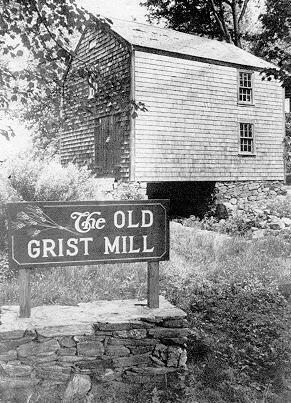Committee Reports Progress
Hampton Union, Thursday, September 7, 1961
[The following article is courtesy of the Hampton Union and Seacoast Online.]

[Courtesy photo was not in the original article.]
Mr. Donald Ring, chairman of the special committee appointed by the town to look into the possible restoration of the Deacon Tuck Grist Mill on High street, has reported that his committee met last week to review the past year's progress and to plan for future work.
The committee of Miss Adeline Marston, H. Alfred Casassa, John MacInnes and William Barkley released their report following the meeting.
"Progress during the 1960-61 season has been quite satisfactory despite the many month's delay occasioned by the State Highway Department's tentative plans to destroy the mill for construction of the new Route 101 extension. These plans have now been changed and the mill, purchased for the town by farsighted voters last year, is no longer in danger.
"The state has been contacted by Mr. Casassa and has indicated interest and favorable comments on the mill project. The Water Resources Board engineers must approve the designs before the town can alter the structure of the dam.
"Much historical data on this and other local mills has been recorded by Miss Marston. Mr. Ring emphasized that the rebuilding of the historic site is a matter of community interest and, therefore; the committee urges all Hampton supporters to write or phone Miss Marston or the HAMPTON UNION at once if they know of any historical data concerning any of the local mills.
"The committee is especially interested in obtaining parts of grist mill machinery such as mill stones, gears, wheels, chutes, sieves, scoops or any other items for use in the machinery or in the museum. Anyone willing to donate such items is urged to contact Mr. MacInnes, who is supervising the search for grist mill artifacts. Due recognition will be made in the acknowledgement plaque to be mounted in the finished project.
"A great deal of engineering information on the design and construction of early mills and other seventeenth and eighteenth century structures has been acquired by the committee, Mr. Ring reported.
"Photographs, dimensions and sketches of flumes, water wheels, gearing conveyors and other items have been obtained. It is felt that when the restoration is finished it will present a quite complete and correct demonstration of how early Hampton settlers harnessed waterpower and ground their grain.
"Although much of the machinery will have to be built of new wood (but using early hand techniques) as much as possible of the old parts and materials as possible, of course, will be incorporated.
"Plans for the future include early reconstruction of the timber flume through which Nilus Brook flows under the mill. This work is necessary at once in order to stop the erosion of the existing dam. The flume will copy early timber work. but the wood will probably be chemically treated to retard rot a feature which our ancestors would have liked but which of course was not then understood. This treatment should make the restoration last longer than the original flumes but will not spoil the outward appearance of the work.
"Although the final development of the site has not been fixed, present plans call for a stairway to the top of the dam at the west, a scenic promenade along the dam across the new flume and a new entrance to the mill at the northeast.
"Within the mill a balcony would conduct the visitors past the several levels of the working machinery and the visitors would leave the building through a new door at the southeast corner. Parking would be off High Street adjacent to the present stone flume.
"The side of the mill facing west would be partially open, so that cars approaching the beach on High street would see the wheel turning and would be greeted by an appropriate sign inviting them to visit the mill.
"During the dry seasons when there is insufficient water to run the wheel, the works would be driven by an electric motor such as is seen at Sturbridge Village so that the demonstration can be used throughout the summer."
Mr. Ring stated that preliminary designs based on these ideas will be developed this fall and he hoped that by spring sketches and specifications might be available for study by the many friends of the mill restoration project.
